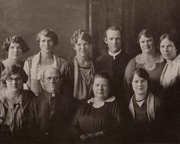In that one statement, they got it right. The hypothesis that Jeremiah's ancient prophecies of doom on Babylon may be playing out in modern-day Iraq has not escaped the attention of the History Channel. An episode of Decoding the Past: Prophecies of Iraq [link to archived site updated 08-29-08] will run on Monday, November 13th at 11am and again at 5pm. [link to archived youtube videos updated 09-01-10:]

The producers, however, give nod to those who say the prophecies deal strictly with the ancient capital city, also called Babylon: "It was one of the greatest cities ever depicted in biblical text. Hebrew prophets of the Bible all predicted its destruction -- as many as 150 years before it happened. And, when in 539 BCE, Babylon fell to Cyrus the Great of Persia, the prophets were thought to have been proven correct."
As I've noted already, however, Jeremiah's prophecy is explicit in its description of doom upon the entire "land of the Chaldeans" and all her "cities... and... environs", not just upon the single city. And this argument has not gone unnoticed by the History Channel: "Ancient Babylon is now known as modern-day Iraq, and eerily similar parallels exist between the prophecies of Babylon and the events of the late 20th and early 21st centuries--including both Gulf Wars and the downfall of Saddam Hussein. Is it possible that Biblical prophecies are playing out in modern times?"
I, of course, say yes, and am exploring those similarities between Jeremiah's curse on the land of Babylon and the events of the current coalition occupation of Iraq and its subsequent near-future events here in this weblog. My position is based on the premise that Jeremiah's decrees are against the "whole land" of the Chaldeans -- Iraq as a nation -- and not meant at all for just the one-time capital city long gone.
But I fear the idea remains stuck in the head for many, for the History Channel continues: "But scholars and academics have long debated the question of whether these ancient predictions were meant for the city of Babylon of more than 2,500 years ago, or whether they referred to a different Babylon, a future Babylon to be rebuilt where the old city once stood."
I say, forget the city once called Babylon, and forget a future rebuilt city on its ancient site, and take Jeremiah for what he said -- he is talking about Babylon the kingdom, the "land of the Chaldeans" (Jer. 50:1) -- now Iraq the nation -- and not just about the capital city of that ancient kingdom also called Babylon, a city now gone. He is talking about the "inhabitants of Chaldea" (Jer. 51:24), the whole region, not just the inhabitants of one ancient city. He is talking about "the land of the Chaldeans", not one city. He is talking about the "cities" and "all (the) environs" (Jer. 50:32) of Babylon, not just the one-time city called Babylon.
When people can come to take Jeremiah as if he said what he meant and meant what he said, then they may be able to figure out what he was talking about. It was the land of Babylon, not the city of Babylon. Like the state of New York, not just the city of New York. Like the country of Kuwait, not just the city also called Kuwait. There is more beyond Manhattan, however that may come as a shock to some.
I look forward to watching the History Channel's offering, but expect to be disappointed. Then I won't be disappointed.
Labels: Final Outcome - Complete Desolation, Iraq is Babylon of Jeremiah 50-51, Not about dead city Babylon











